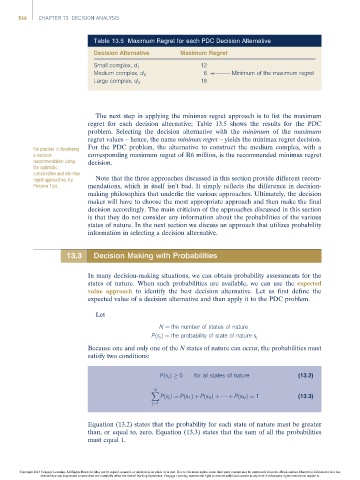Page 566 -
P. 566
546 CHAPTER 13 DECISION ANALYSIS
Table 13.5 Maximum Regret for each PDC Decision Alternative
Decision Alternative Maximum Regret
12
Small complex, d 1
6 Minimum of the maximum regret
Medium complex, d 2
16
Large complex, d 3
The next step in applying the minimax regret approach is to list the maximum
regret for each decision alternative; Table 13.5 shows the results for the PDC
problem. Selecting the decision alternative with the minimum of the maximum
regret values – hence, the name minimax regret – yields the minimax regret decision.
For practise in developing For the PDC problem, the alternative to construct the medium complex, with a
a decision corresponding maximum regret of R6 million, is the recommended minimax regret
recommendation using decision.
the optimistic,
conservative and minimax
regret approaches, try Note that the three approaches discussed in this section provide different recom-
Problem 1(b). mendations, which in itself isn’t bad. It simply reflects the difference in decision-
making philosophies that underlie the various approaches. Ultimately, the decision
maker will have to choose the most appropriate approach and then make the final
decision accordingly. The main criticism of the approaches discussed in this section
is that they do not consider any information about the probabilities of the various
states of nature. In the next section we discuss an approach that utilizes probability
information in selecting a decision alternative.
13.3 Decision Making with Probabilities
In many decision-making situations, we can obtain probability assessments for the
states of nature. When such probabilities are available, we can use the expected
value approach to identify the best decision alternative. Let us first define the
expected value of a decision alternative and then apply it to the PDC problem.
Let
N ¼ the number of states of nature
Pðs j Þ¼ the probability of state of nature s j
Because one and only one of the N states of nature can occur, the probabilities must
satisfy two conditions:
Pðs j Þ 0 for all states of nature (13:2)
X
N
Pðs j Þ¼ Pðs 1 Þþ Pðs 2 Þ þ þ Pðs N Þ¼ 1 (13:3)
j¼1
Equation (13.2) states that the probability for each state of nature must be greater
than, or equal to, zero. Equation (13.3) states that the sum of all the probabilities
must equal 1.
Copyright 2014 Cengage Learning. All Rights Reserved. May not be copied, scanned, or duplicated, in whole or in part. Due to electronic rights, some third party content may be suppressed from the eBook and/or eChapter(s). Editorial review has
deemed that any suppressed content does not materially affect the overall learning experience. Cengage Learning reserves the right to remove additional content at any time if subsequent rights restrictions require it.

